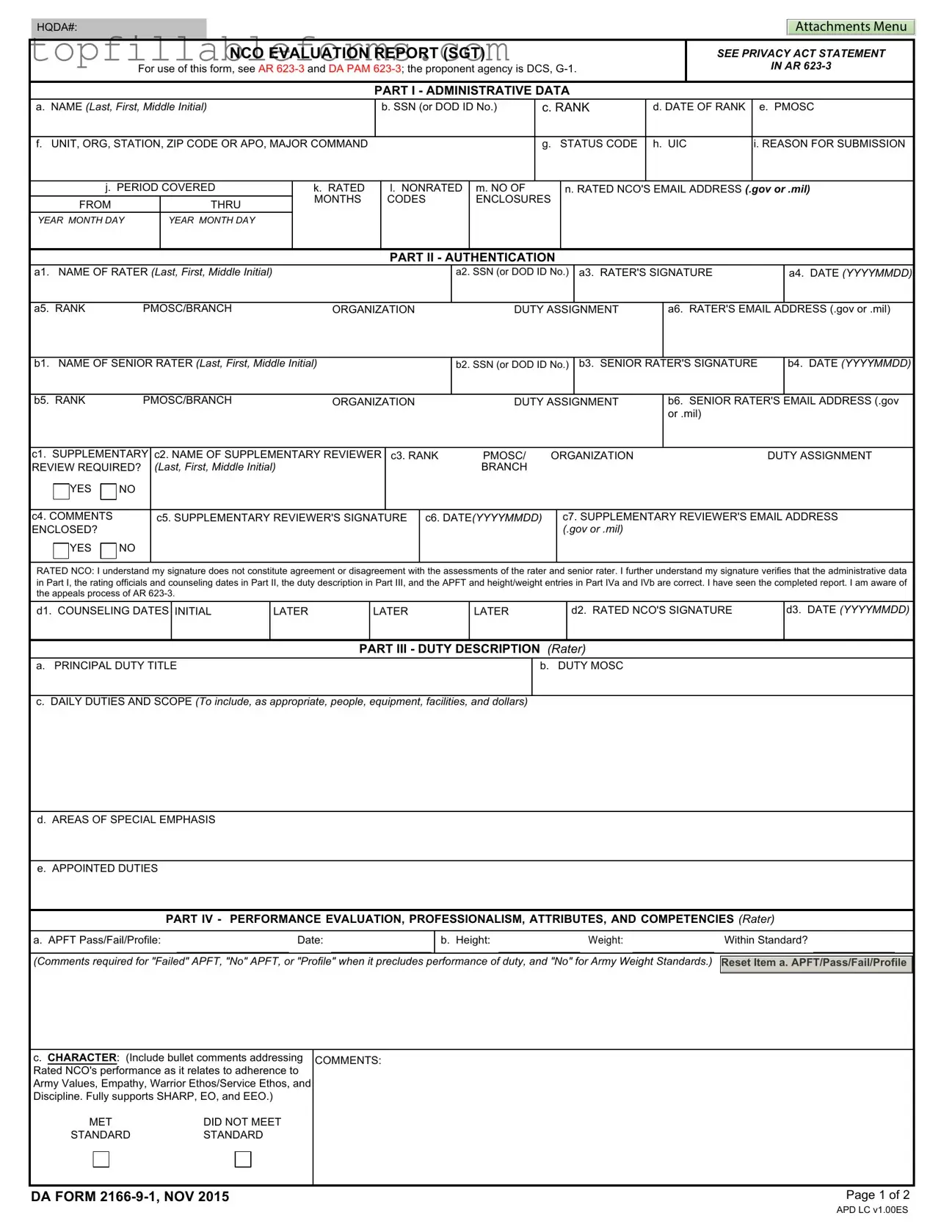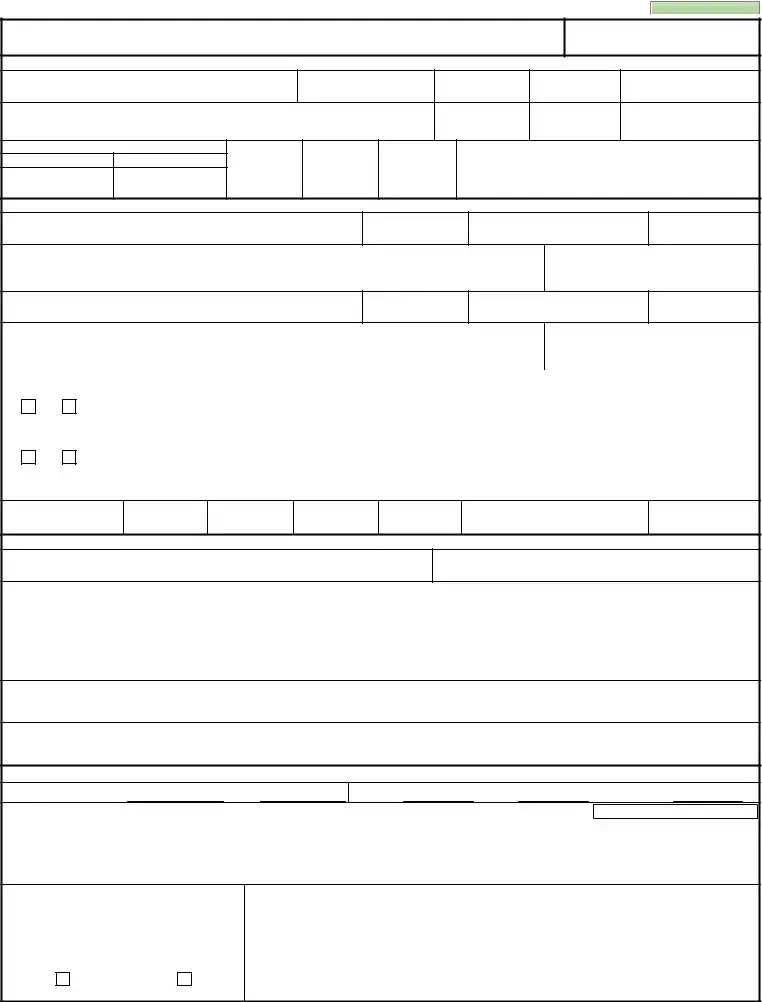NCO EVALUATION REPORT (SGT)
For use of this form, see AR 623-3 and DA PAM 623-3;; the proponent agency is DCS, G-1.
SEE PRIVACY ACT STATEMENT
IN AR 623-3
PART I - ADMINISTRATIVE DATA
a.NAME (Last, First, Middle Initial)
f. UNIT, ORG, STATION, ZIP CODE OR APO, MAJOR COMMAND
j. PERIOD COVERED
FROMTHRU
YEAR MONTH DAY |
YEAR MONTH DAY |
n. RATED NCO'S EMAIL ADDRESS (.gov or .mil)
PART II - AUTHENTICATION
a1. NAME OF RATER (Last, First, Middle Initial)
a5. RANK |
PMOSC/BRANCH |
ORGANIZATION |
a6. RATER'S EMAIL ADDRESS (.gov or .mil)
b1. NAME OF SENIOR RATER (Last, First, Middle Initial)
b3. SENIOR RATER'S SIGNATURE
b5. RANK |
PMOSC/BRANCH |
ORGANIZATION |
DUTY ASSIGNMENT |
b6. SENIOR RATER'S EMAIL ADDRESS (.gov or .mil)
c1. SUPPLEMENTARY |
c2. NAME OF SUPPLEMENTARY REVIEWER |
c3. RANK |
PMOSC/ |
ORGANIZATION |
DUTY ASSIGNMENT |
REVIEW REQUIRED? |
(Last, First, Middle Initial) |
|
|
BRANCH |
|
|
|
YES |
NO |
|
|
|
|
|
|
|
|
|
|
|
|
|
|
c4. COMMENTS |
|
c5. SUPPLEMENTARY REVIEWER'S SIGNATURE |
c6. DATE(YYYYMMDD) |
|
c7. SUPPLEMENTARY REVIEWER'S EMAIL ADDRESS |
ENCLOSED? |
|
|
|
|
|
|
(.gov or .mil) |
|
YES |
NO |
|
|
|
|
|
|
|
|
|
|
|
|
|
|
|
|
RATED NCO: I understand my signature does not constitute agreement or disagreement with the assessments of the rater and senior rater. I further understand my signature verifies that the administrative data in Part I, the rating officials and counseling dates in Part II, the duty description in Part III, and the APFT and height/weight entries in Part IVa and IVb are correct. I have seen the completed report. I am aware of the appeals process of AR 623-3.
d1. COUNSELING DATES INITIAL
d2. RATED NCO'S SIGNATURE
PART III - DUTY DESCRIPTION (Rater)
c.DAILY DUTIES AND SCOPE (To include, as appropriate, people, equipment, facilities, and dollars)
d.AREAS OF SPECIAL EMPHASIS
e.APPOINTED DUTIES
PART IV - PERFORMANCE EVALUATION, PROFESSIONALISM, ATTRIBUTES, AND COMPETENCIES (Rater)
a. APFT Pass/Fail/Profile: |
Date: |
b. Height: |
Weight: |
Within Standard? |
(Comments required for "Failed" APFT, "No" APFT, or "Profile" when it precludes performance of duty, and "No" for Army Weight Standards.) Reset Item a. APFT/Pass/Fail/Profile
c.CHARACTER: (Include bullet comments addressing Rated NCO's performance as it relates to adherence to Army Values, Empathy, Warrior Ethos/Service Ethos, and Discipline. Fully supports SHARP, EO, and EEO.)
MET |
DID NOT MEET |
STANDARD |
STANDARD |
DA FORM 2166-9-1, NOV 2015 |
Page 1 of 2 |
RATED NCO'S NAME (Last, First, Middle Initial) |
SSN (or DOD ID No.) |
THRU DATE |
|
|
|
PART IV - PERFORMANCE EVALUATION, PROFESSIONALISM, ATTRIBUTES, AND COMPETENCIES (Rater)
d. PRESENCE: (Military and professional |
COMMENTS: |
bearing, Fitness, Confidence, Resilience.) |
|
MET |
DID NOT MEET |
|
STANDARD |
STANDARD |
|
e. INTELLECT: (Mental agility, Sound judgment, COMMENTS: |
Innovation, Interpersonal tact, Expertise.) |
MET |
DID NOT MEET |
STANDARD |
STANDARD |
f. LEADS: (Leads others, Builds trust, Extends COMMENTS: |
influence beyond the chain of command, Leads by |
example Communicates.) |
|
MET |
DID NOT MEET |
STANDARD |
STANDARD |
g. DEVELOPS: (Creates a positive command/ COMMENTS: |
workplace environment, Fosters esprit de corps, |
Prepares self, Develops others, Stewards the |
profession.) |
|
MET |
DID NOT MEET |
STANDARD |
STANDARD |
|
|
h. ACHIEVES: (Gets results.) |
COMMENTS: |
MET |
DID NOT MEET |
STANDARD |
STANDARD |
|
|
|
|
|
|
RATER OVERALL PERFORMANCE |
|
i. I currently rate |
NCOs in this grade. |
|
COMMENTS: |
|
|
|
|
|
|
|
|
|
|
|
|
|
|
|
|
|
|
|
|
PART V - SENIOR RATER OVERALL POTENTIAL |
a. Select one box representing Rated |
b. COMMENTS: |
|
NCO’s potential compared to others in the |
|
|
same grade whom you have rated in your |
|
|
career. I currently senior rate |
|
|
NCOs in this grade. |
|
|
|
|
|
|
|
|
|
|
|
|
MOST QUALIFIED |
|
|
|
|
|
|
HIGHLY QUALIFIED |
|
|
QUALIFIED |
|
|
|
|
|
|
NOT QUALIFIED |
|
|
|
|
|
|
|
|
|
c. List two successive assignments and one broadening assignment (3-5 years). |
|
Successive Assignment: |
1) |
|
|
2) |
Broadening Assignment: |
|
|
|
DA FORM 2166-9-1, NOV 2015 |
|
Page 2 of 2 |
|
|
|
|
|
|
|
APD PE v1.00ES |


